Farmington Country Club (East Course)
Virginia, United States of America
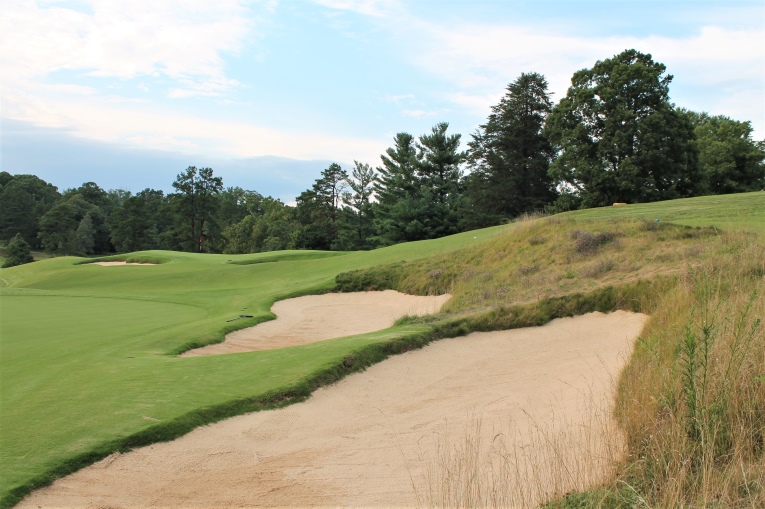
Give Farmington Country Club credit for allowing Coore & Crenshaw to create an unconventional ten hole course. Measuring 2,206 yards, it represents a fun romp through the Virginia countryside and is the sort of fast playing course of which America needs many more.
Third nines get the short shrift most of the time. They are usually laid over leftover land and generally done by an inferior architect. A handful of notable exceptions exist such as Flynn’s Primrose at The Country Club and Simpson’s work at Morfontaine but few clubs are as lucky. To the extent that the club is well run, the question eventually becomes: is the third nine the ‘best it can be and we are stuck with it’ or can something else be done?
Southern Hills in Tulsa had the wisdom to call in architects of the stature to their main course in the 1990s, when Coore & Crenshaw revamped nine holes and all sorts of members now find it appealing. It is just another example of why Southern Hills is one of America’s preeminent country clubs. In a similar vein, Farmington Country Club with its Thomas Jefferson building, on-site accommodations, rambling property and diverse offerings in the foothills of the Blue Ridge mountains surely ranks among the dozen or so most appealing clubs in the country for a family membership.
Despite the steady drum beat of troubling news for private clubs in America, Farmington is bustling and enjoys over 30,000 rounds on its main course. In recent times, though, play on the ‘spill-over’ nine built by architect Buddy Loving (the grandson of the Scot Fred Findlay who built Farmington’s main course in 1927) had dropped and interest waned. The nine holes weren’t so much bad as just awkwardly hard and play over them did little toward improving one’s opinion of them. That isn’t to take anything away from Loving, whose family enjoys an exalted place at the club. His father, Raymond was the General Manager for an astonishing 51 years from 1928 to 1979 and the club’s medal play championship is the Loving Cup. Loving’s marching orders from the club in 1966 were – not surprisingly – to produce a conventional nine hole layout and that’s what he did with his 2900 yard, par 34 effort.
Fifty years on, the Green Committee determined that the third nine and practice area were no longer up to snuff with the rest of the club’s offerings. A Farmington Green Committee member had a relationship with Bill Coore, leading to the committee reaching out to him to have a look. Coore’s initial tour of the third nine didn’t elicit much enthusiasm. The holes were adequate but Coore didn’t see how to make the golf rousing. Eventually, he determined that the land, which features plenty of movement, was better suited for short holes. Therein lies the rub – if a club shackles an architect to something standard/conventional like they did with Loving, he may not best use the land. Scores of time across this country, clubs, developers, and owners have asked/demanded that architects build something rigid (e.g. a championship 18 hole course with returning nines that measures over 7000 yards) on land poorly suited to such a bloated undertaking.
Coore concluded that if this land at Farmington was viewed from a different perspective, a fun short course could emerge as well as a spacious practice area and teaching facility. Coore instinctively knew that one key would be push through and overcome preconceived notions. That may sound cliché but with 40 years in the field, walking thousands of miles Bill Coore understands land and its potential for great golf. So, if the best way to get the most interesting golf from the land was to build several consecutive par 3s, so be it. Par and distance be damned.
Would the club agree? To their eternal credit, they did, after appreciating how the existing space could be better employed. Coore & Crenshaw were given the green light and Coore set about doing something different. This creative license was the very reason Dave Axland signed on as project lead, despite Coore & Crenshaw having a project in Axland’s home state of Missouri. Talent was brought in – Rodney Cole was there from the start, Dan Proctor, Keith Rhebb, Rod Whitman (of Cabot fame in Nova Scotia), Ryan Farrow all took turns in what Axland deems to be ‘one of the most rewarding projects with which I have ever been associated.’ Add Green Keeper Scott Kinnan and his eager crew and that is a lot of talent for ten holes. Happily, the results are now in the ground and play commenced late June, 2017. There are 10 holes, not the usual nine. There are six one shotters, either three or four two shotters, and perhaps one three shotter (depending on your age/talent). To care about the total length is to miss the point.
What are the highlights? The same things golfers have delighted in finding on Cooore & Crenshaw designs for thirty years; width, central bunkers, greens that fall away, approach shots where you aim at x to end by y, deep bunkers, bold greens surrounded by short grass, and a ruff hewn look. Additionally, there’s a 70 yard (!) hole that you will never see or play anywhere else. It all adds up a rollicking good time that can be enjoyed in a bit over an hour.
Completely non-standard, the ten holes at Farmington represent the exact sort of fast playing, thought provoking golf of which America needs more. Have a read below and see if you concur.
Holes to Note
First hole, 190 yards; Why not let the player know he’s in for a treat from the start? Make him immediately glad to be here and not on the main course? That is exactly what occurs. From the tee, the view down the hill provides instant appeal. More importantly, the land’s natural grade flows through the back of the green so that the ground continually slopes away from the golfer, making the hole an exercise in judgement on how to use the ground to access the varying hole locations. A primary reason the author is an enormous fan of Coore & Crenshaw’s first design, Kapalua Plantation in Hawaii, is its multitude of front to back greens. For the author, these are more interesting to approach than conventional push-up greens that slope from back to front (like a catcher’s mitt as Max Behr once lamented). Axland is particularly fond of how flexible this hole turned out, as well he should be. Its high front left hole location is the devil to get close to and pairs up nicely with a forward right tee from ~130 yards that allows the golfer to gain sufficient height to potentially get close.
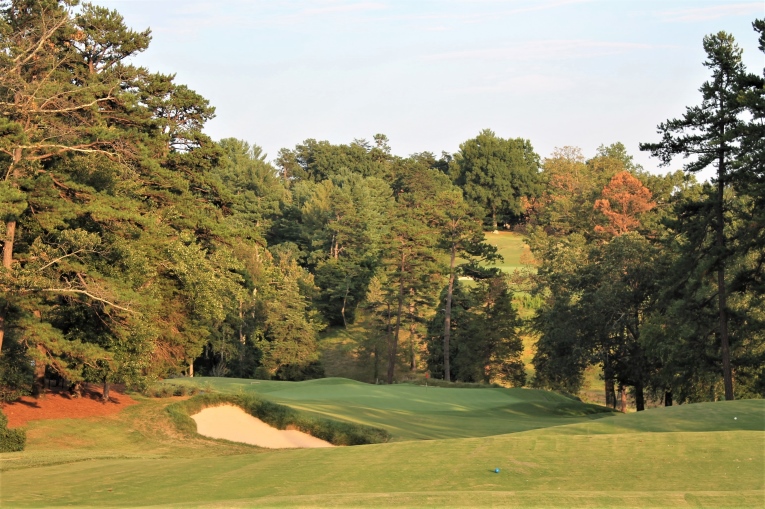
Hard as it may be to fathom, a tee ball up and over the trees left perfectly accesses back right hole locations!
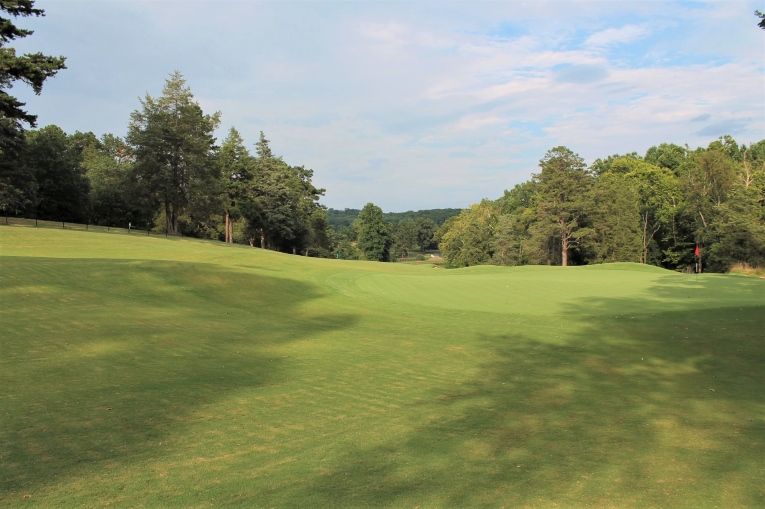
A non-golfer might not find this photograph sexy but anyone who appreciates links golf will love the sight of a bunch of short grass sharply tilted toward an open putting surface.

As seen from behind the green, the major landforms expertly spill onto the putting surface. Plus, the green falls nearly three feet from front to back so that a premium is placed on the ground game.
Second hole, 255 yards; The golfer most likely to be irritated on this course is the tiger, or at least the tiger that pulls driver from his bag at the two shotters, which narrow the longer one goes from the tee. This one is particularly confounding because of its length (or lack thereof). It practically begs the golfer to have a slash at the green with predictable results – more double bogeys and higher have been registered here during the course’s first seven weeks of existence. Alas, being smart enough to hit a six iron off the tee doesn’t come naturally to many golfers.

Though the green is open in front, the pronounced left to right tilt and the firmness of the Latitude Bermuda fairways conspire to shunt the ball relentlessly right and out of position. However, a mid iron off the tee stays short of the trouble.
Fourth hole, 70 yards; Old Tom Morris would love this hole. Why? Old Tom became disgusted over time that there was a club for every shot. Where is the skill in that, he groused. Here, the golfer faces a teed up shot that he never plays or likely practices. As a result, this diminutive hole is far more frustrating than one might think. Originally, the architect from the 1960s skipped this morsel of land and took the golfer to today’s fifth tee. Freed from convention, Coore and company decided why walk when you can play golf. The tiny 1500 square foot, two tiered green provides both solace (front left hole locations might render a hole-in-one) and gnashing of the teeth (back right is reserved for fools to chase).
Fifth hole, 355 yards; A great hole by every metric, Axland calls this ‘Coore at his best.’ Silty soup from the pond on the third hole was drained and piled into this fairway to see if more interesting contours for golf could be established. Sure enough, with time, a high road/low road approach materialized. Take the lower, more direct path right and enjoy the best look down the spine of an angled green. The catch is severe trouble in the form of a diagonal creek and jungle protect that route. For those that play safely left, a knob twenty yards short obscures the green and everything but the top of the flag. The evolution of this hole is a prime example of where the crew’s talent makes a big, lasting difference. Rod Whitman, who has done so much to enthuse character into golf around the world (often times with his friend Bill Coore), joined the Coore team and together, they lifted the golf quality of this fairway/hole immeasurably from its precursor. The fifth ranks with the very best of the twenty-seven holes on offer at Farmington.
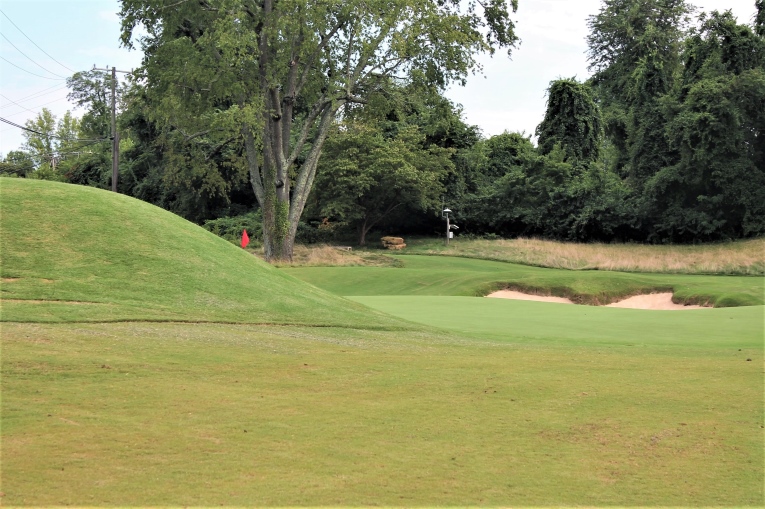
For those that play safely left off the tee, depth perception becomes problematic for one’s approach as this mound 20 yards short of the green hinders a clean view of the target.
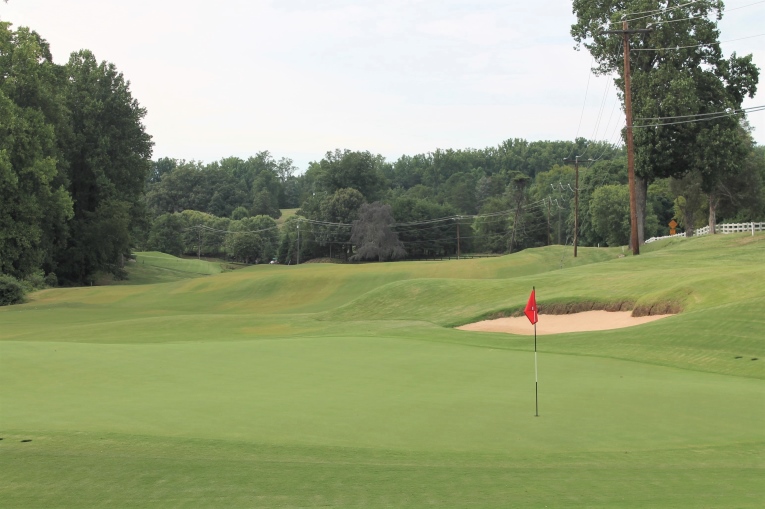
As seen from behind, the gorgeous yellow tinged fairways and playability of the turf are a complement to the green keeping staff. From the start, Coore emphasized that the ability of the ball to scoot forward was far more important than the color green.
Sixth hole, 375 yards; A shortcoming of most relief courses is that they don’t train the golfer to think. Therefore, they don’t assist the golfer when he plays elsewhere. This fairway balloons to the right while the hole swings left and the most fearsome hazards are, of course, down the left. It is easy to imagine the golfer playing to the right for several rounds before gradually deciding on a shorter approach and a better angle. He eventually becomes too greedy down the left and gets in all sorts of trouble. Next time? He is back to the right off the tee. Regardless, the process of learning when – and when not – to seek an advantage is something that stays with the golfer no matter where he travels.

The new 6th hole occupies the same playing corridor of Loving’s 4th hole but Coore opened the area behind this horizon green making an inspired view of the flag silhouetted against the Blue Ridge mountains.
Seventh hole, 170 yards; Three one shotters follow in succession and the first two play back and forth across the same valley. Coore knew, ‘The mistake would have been to allow this and the next to look alike. We made a conscious effort to do all we could so that the golfer felt he was tackling two distinct challenges.’ The 7th is made by an elevated horseshoe contour that rings the back of the green from 9 o’clock around to nearly 3 o’clock.
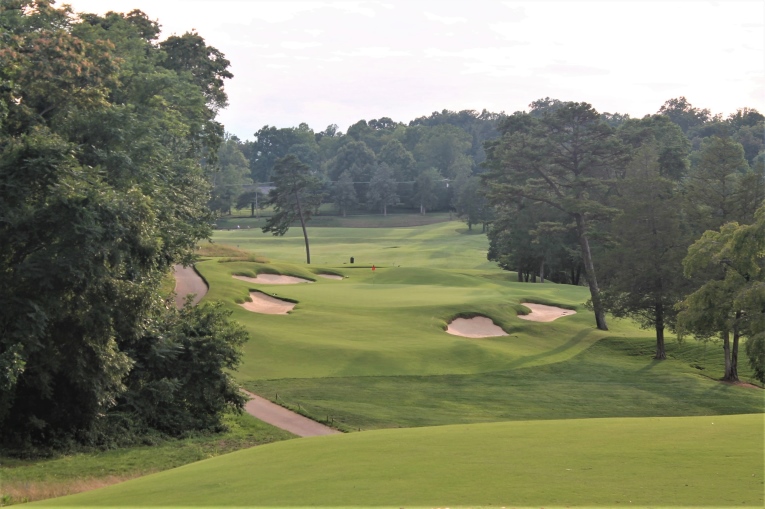
The soft thumb print in the middle of the green makes this back center hole location on a narrow shelve deceptively testy.
Eighth hole, 135 yards; Wider than deep this is a completely different green to the last and features a soft puff in the middle that is the green’s high point. The challenges revolve around that puff. The front ¼ of the green plays essentially as a bowl and to miss it is to court three putts when the hole location is forward.
Ninth hole, 130 yards; Sidehill holes are rarely as diverse or as good as this; in fact, the author can’t think of one where so many playing angles exist in such a short space. In fine contrast to the last two holes, this one shotter is all about the ground game. Similar to the first hole, playing it properly can involve using short grass as much as ten paces off the putting surface. This hole is another of Axland’s very favorites and it is the first one that they worked on.
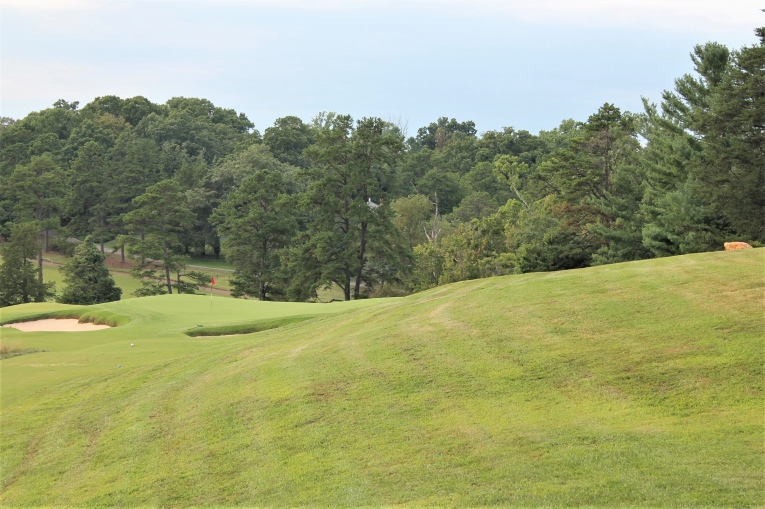
When the flag is left, the golfer can take dead aim or use the nearly three foot drop in the green to feed his tee ball close.
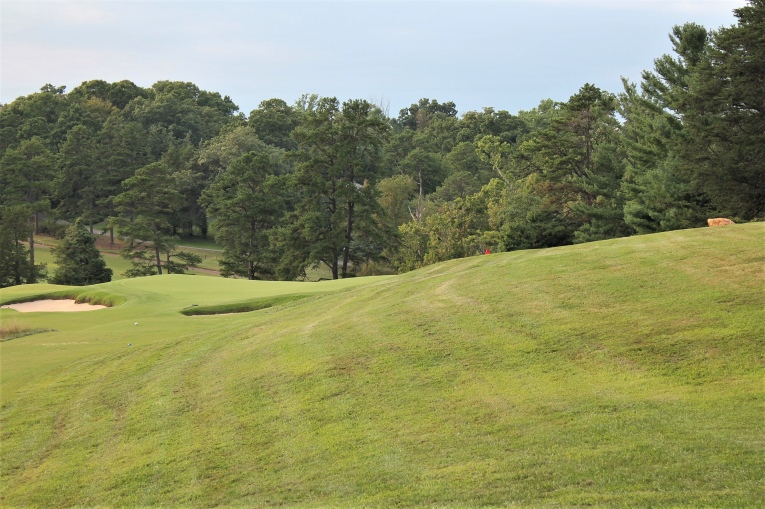
Conversely, when a right flag is just peeking over the hillside, a completely different challenge presents itself. The aim is actually just inside the exposed boulder high right …
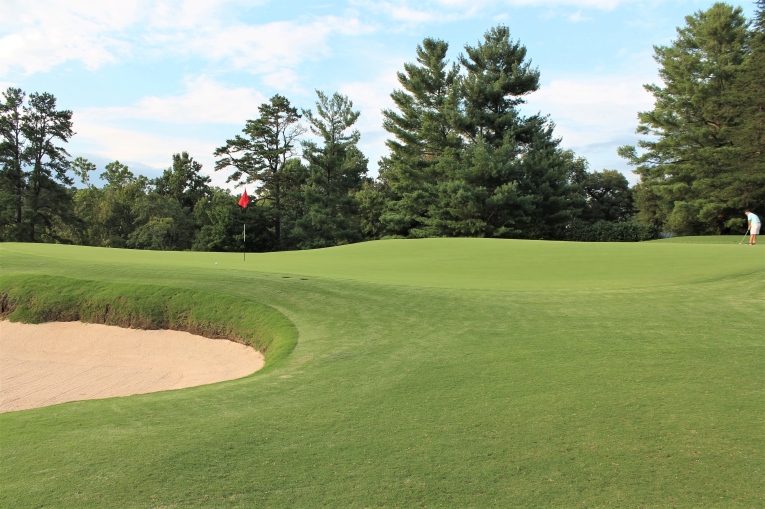
The odds of a two putt are not in the favor of the golfer as he has to cover much of the width of the 9,000 square foot green, the single biggest green on the property.
Tenth hole, 410 yards; Playing steeply uphill this may be a par 4 or maybe it is a par 5. Plenty of club golfers will be content to get their second shot somewhere 50-70 yards shy of the green and that’s where the best fairway contours on the property must be dealt with. A foreboding deep greenside bunker front left pushes golfers right with their approach but much of the green tilts right to left, so … recovery from right of the green is one of the more fiddly shots of the day – and great training for wherever you might play next.
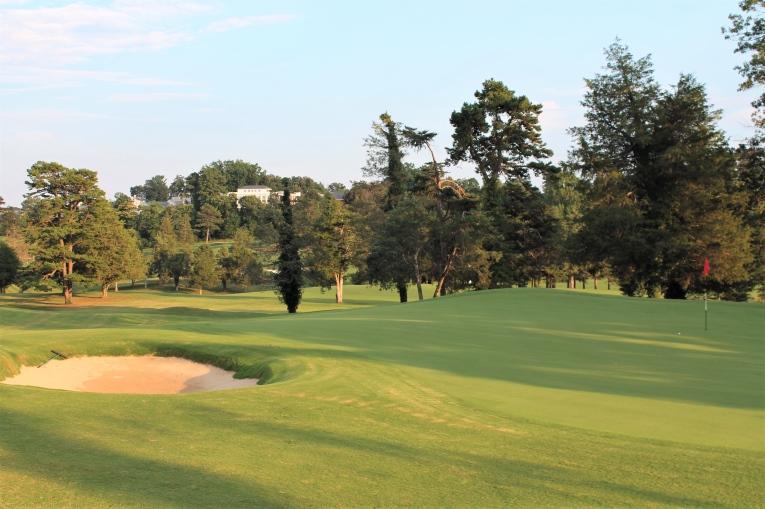
As seen from back right, a false front, hidden bunker, and green that tilts to the left are the last design features present on this ‘little’ course to confound the golfer.
This course in tandem with a significantly enhanced practice and learning area are a great asset to the club and its members. While practicing has its place, the important thing about golf is, well, playing it. As always, the challenge is to find the time but this quick-playing course becomes a viable option when you are limited to an hour and change. Rest assured that this ten holer will ask you to think and hit a slew of different shots with a variety of clubs. Recoveries are every bit as challenging as that on the main course due these sloping greens and deep bunkers . The golf professional has humorously noted that people looked at him like he had ‘burnt their food’ when he relegated them to the nine holer on busy days. After the creation of this gem, such visages are a thing of the past.
Driving away on Old Garth Road that borders the fifth hole, the author saw a father and (presumably) three sons carrying their bags. One of the boys was chipping back up the false side of the green. This informal, unhurried, evening setting reminded me of how I learned to play the game. Mission accomplished on behalf of the club and Coore & Crenshaw.




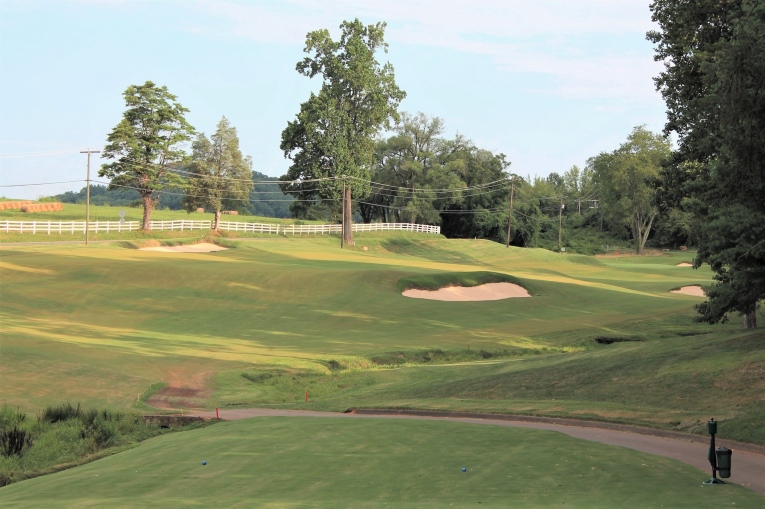
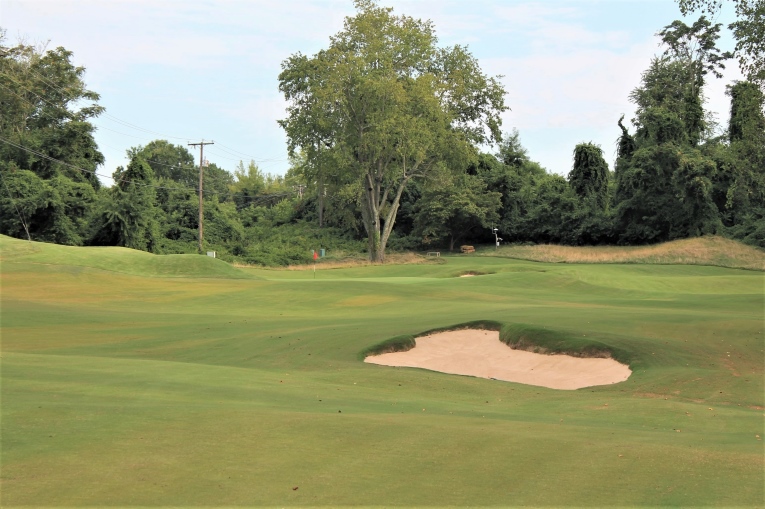
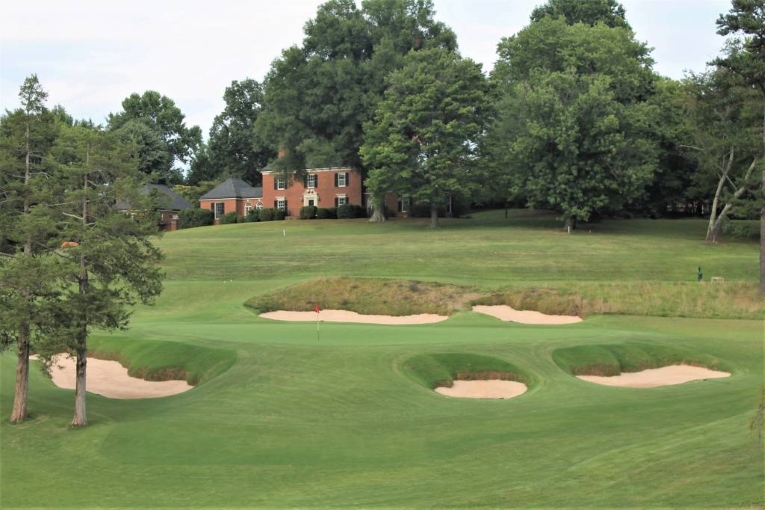
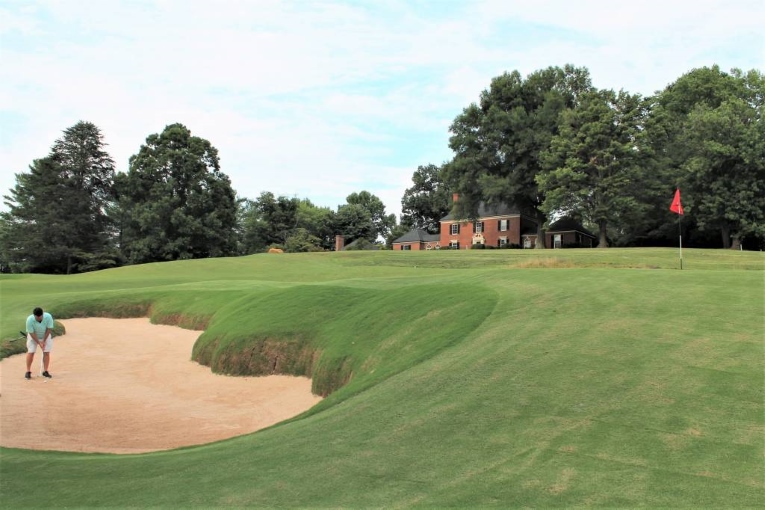





![The Park, West Palm (Lit 9) [2023]](https://golfclubatlas.com/wp-content/uploads/2024/12/IMG_7092-2-scaled-500x383.jpg)


